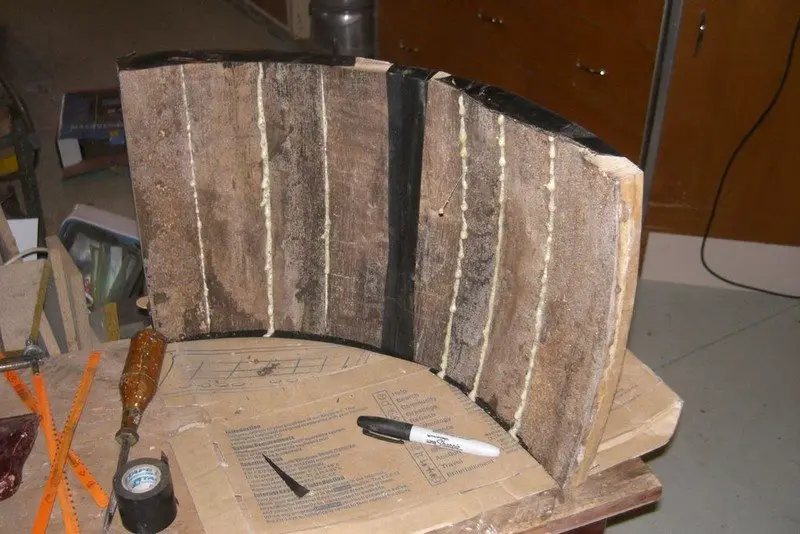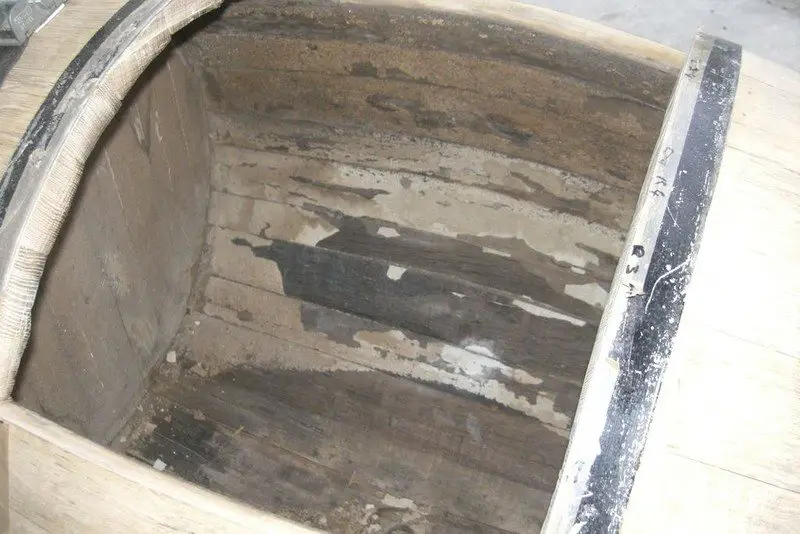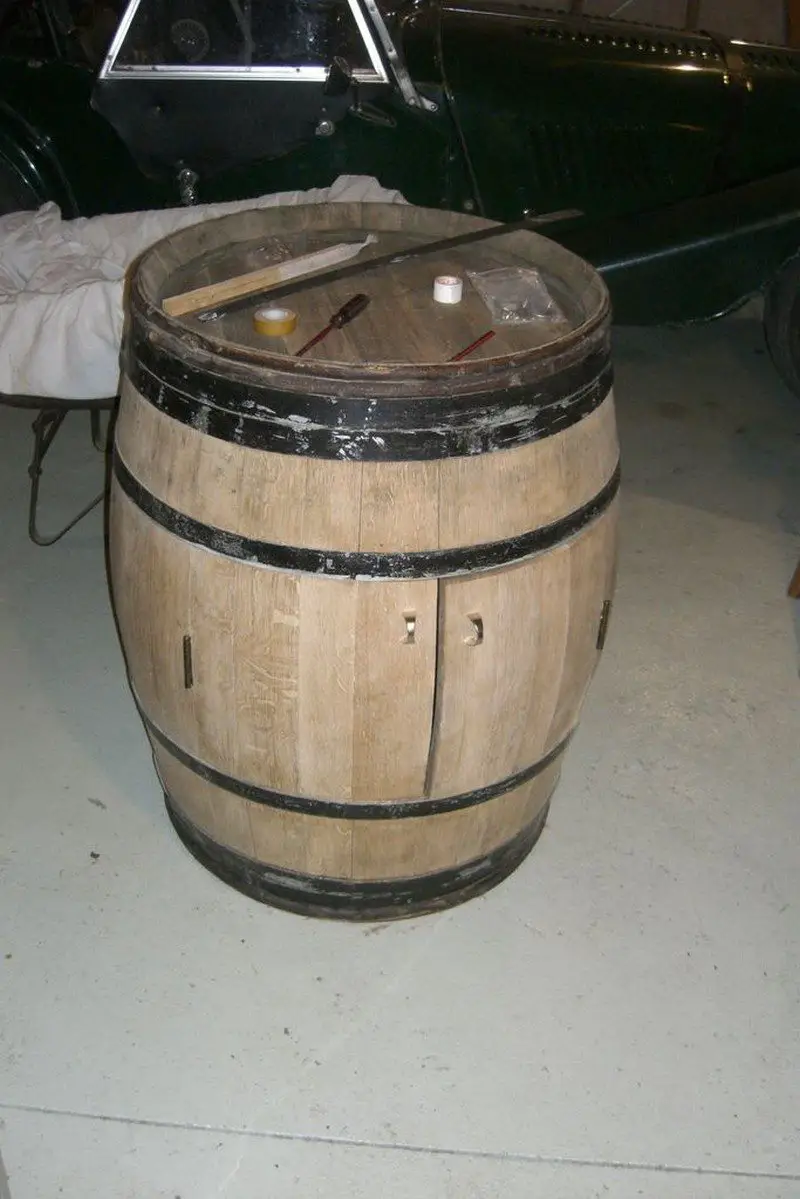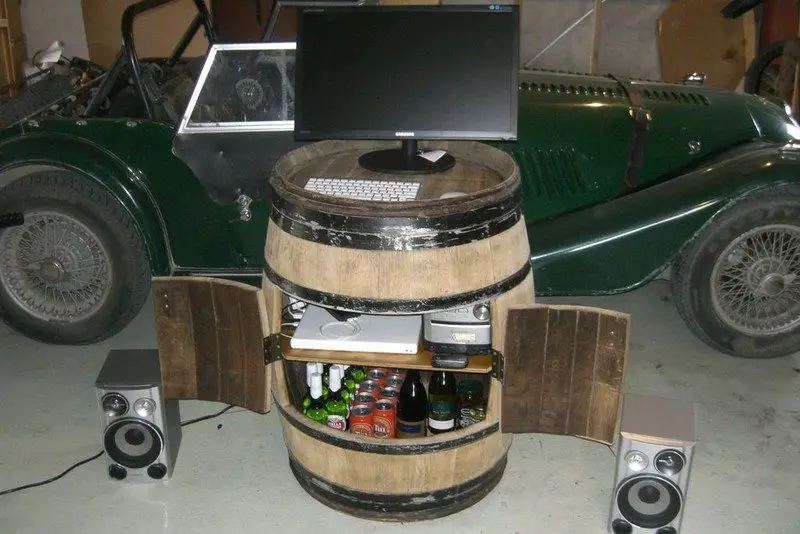If you like the idea of having your alcohol and spirits tucked away but still within easy reach, this repurposed oak barrel bar could work for you. The addition of a simple lock will also keep the kids out of it.

This would also serve as a great gift idea for those you know that love to drink! It’s a great weekend project to take and for making use of those old wine barrels.
Read on to learn how to easily turn one into this beautiful piece of storage.
Materials:
- Cardboard
- Plywood
- Scrap Wood
- Metal and Wood Glue
- Wire Wool
- Screws
- Danish Oil
- Gas Mask & Goggles
- Wheel Barrow draped in sheets
- Hinges
- Door Handles
- Tape
- Sello Tape
- Plastic Wrap
- Damp Cloth and Warm Water
[adinserter block=”11″]
Tools:
- Hammer
- Circular and Small Triangular Shaped Sander
- Hacksaw
- Buzz-saw
- Drill with various Drill Bits
- Measuring Tape
- Scraper
- Vacuum Cleaner
Steps:
It’s up to your personal taste and the state of your barrel whether or not you do this. When I got hold of mine, it was pretty messy, so I gave it a quick sand to clean it up.
Remove the middle two metal bands from the barrel, they should just slide off, but you might need to tap at them with a hammer and piece of wood.
Take the barrel to a well ventilated area, and put it on an old sheet or blanket so it doesn’t get damaged. I did it outside on the grass, and it got a couple of green stains on it (before I put a sheet down), but they came off no bother.
Sand the barrel down with the course paper first on the larger sander, and then do the little fiddly bits (such as next to the other metal bands) with the smaller sander (if you have one). Then go over the whole barrel again with the fine sand paper to get it smooth to the touch.
I sanded the top and bottom too, and then I did the top of the barrel with some wire wool to make it super smooth and to make the grain of the wood stand out a bit more. When using wire wool, rub it in the same direction as the grain of the wood.

Sit the barrel on one end and sit one of the hoops around it. Using a hammer and a scrap piece of wood, carefully tap the hoop down as far as it will go. Use a measuring tape to make sure it is level all of the way around.
Run a piece of cellotape on the wood as close to the hoop as possible. Then tape glad wrap onto this piece of tape, so that no glue will be able to get onto the wood. Do the same on the other side of the hoop.
Take the hoop off gently, trying not to damage the cellotape and gladwrap.
Clean the inside of the hoop using a wire brush or something like that, to get any rust of the metal.
Follow your glue’s instructions to apply it to the hoop and/or the barrel.
Gently slide the hoop onto the barrel again. You might want to align all of the rivets with those of the other bands. In our case, all of the rivets ended up in line with the bung hole on the barrel.
Tap the hoop down with the hammer and wood, so that the hoop is sitting between the two layers of cellotape/gladwrap.
Let the glue set (allow as much time as the glue instructions say).
Remove the cellotape and gladwrap and sand down the wood around the hoops to get rid of any excess glue.
Do the same for the other hoop.

Cutting out the door was one of the trickiest bits in this project, we thought about a number of different ways of doing this part. Our main problem was that there was no-where to start cutting. None of the staves were far enough apart to fit a blade between them. For a while we had considered drilling a small hole at one corner, and starting from there.
In the end, what we did was use a hacksaw and a jigsaw. First we labelled the staves that were to be cut with cellotape. In our case we cut a double door, with four staves on each door, so we cut eight staves in total. We also completely covered the doors with tape, so they would stay together and keep their shape. Label which end is top and which end is bottom as well, or do something so you’ll know which way to orientate the door once you’ve cut it out.
This is also the point where you decide which part of the barrel you want the door cut out of. In our case, the bung hole in the barrel will be used to pass power cables in and out of the barrel (they fit beautifully without any adjustment!). So, our door is directly opposite the bung hole. You could also cut it so that the bung hole is on the door, and use it as a sort of handle to open and close the door. It’s entirely up to you how you end up doing it.
We started cutting with the hacksaw, until we’d cut right through the wood into the inside of the barrel. From there we used the jigsaw to cut the rest of the doors.
Because the individual staves aren’t stuck together, we only had to cut the top and bottom of the staves, not the sides.
Care should be taken to make the cut as straight as possible, because any wobbles will come back to haunt you later, as we found out.

Next we glued the staves of the door together. We decided to make our barrel have double doors, so we didn’t glue the middle two together (but we kept them taped together, to make sure everything would still fit together).
Cover the top and bottom of the door with tape to stop the glue going everywhere.
Lie the door on it’s convex face (so that the inside surface of the door is facing up). Gently separate two adjacent staves, and squeeze a line of glue down them. Repeat this for each of the other staves (except the middle ones, if you want a double door).
Put an old sheet, some newspaper or a plastic sheet inside the barrel, to protect it from any glue that might drip onto it.
Lift the door back into its hole in the barrel, making sure it sits relatively snuggly with the neighboring staves.

Tie a rope or something around the barrel to hold the door down, and let the glue set.
Once the glue has set fully, remove the rope and the door. Take all the tape off the door and use a scalper blade and a sander to get rid of any excess glue. If your barrel has been used to age wine, you will also likely need to gently sand the inside surface of the door to remove the crystals that have settled onto the wood.

This was the messiest step. You might want to wear some goggles and a gas mask or something because there will probably be a lot of dust flying around.
Use a scraper to get most of the muck off. Depending on how much you get off, you might want to vacuum it out before sanding it.
Use the sander on the inside of the barrel. We just sanded it down enough so that nothing loose was left on the wood, so nothing would flake off later.
Vacuum out the inside again.
Use a damp cloth to wipe out the inside of the barrel to get rid of most of the dust. Don’t worry if the cloth seems to come away very dark. This happened to us, and I think it was because the inside of the barrel is stained with the red wine that was aged inside it.

Decide what height you want the shelf in the barrel to be. When making this decision, it is very important to decide what you want to store in each part of the barrel. In our case, we decided that the bottom part of the barrel will be used to store wine, beer and some food. So we needed the bottom compartment to be tall enough in order to stand a full bottle of win. In the top part, we wanted to put a stereo, a laptop and a powerboard, with cables leading out of the bung hole. We ended up making the shelf sit just below the bung hole. This left enough room in both compartments for everything we wanted, and also let us run all of the cables out of the bung hole.
Measure the diameter of the barrel at this point, and use it to draw and cut out a piece of cardboard to use as a template.

We decided that in order to be able to reach everything in the bottom half of the barrel easily, and to make it easier to put the shelf in, we would cut part of the shelf out (see attached picture). To do this, we first put the cardboard template inside the barrel (we had to bend it slightly to do this), and then draw a line on it from one side of the doorway to the other. Cut the piece off the cardboard that you marked, and slide the the template in again to make sure it goes in without having to bend it.

Use the template to mark and cut out your shelf. We used some plywood, but you can use anything you want. You can smarten the shelf up a little bit if you want by sanding it and oiling it (we used Danish oil), or you could stain it.

Now we need to make some brackets on which to mount the shelf.
What we did was get an old piece of oak, and cut three slightly curved pieces out. We then held them in the barrel with the shelf on top, where we wanted the shelf to sit. Using a spirit level sitting on the shelf, we adjusted the supports until the shelf was sitting flat and level. We marked where each of the supports would sit, and then drilled holes from them and screwed them in. We also drilled holes in the shelf to screw it onto the supports to make it as secure as possible.
Take the shelf out (but not the supports) to make the next step easier.

Now we need to screw the hinges onto the doors, and then the doors onto the barrel.
For the hinges, we had to cut out a small indentation in both doors and the barrel itself so that the door sits flush against the barrel when closed.
Drill holes for the screws, and then screw the hinges in place on the door.
We taped several pieces of card onto the barrel, so that we knew there would be enough space above and below the doors for them to close without much drama.

Drill holes into the barrel for the screws, and then screw the hinge onto the barrel.
Do the same for the other door.
Take the card off the barrel, and make sure the doors close properly. Check again when the barrel is standing upright, to make sure the doors don’t sag too much. If they do you might need to adjust the hinges. We had to put a couple of pieces of small card between the hinges and the wood (of both the door and the barrel).

The left door on our barrel was closing perfectly, and needed no other adjustments. However, the right door didn’t seem to want to shut properly, possibly because the line wasn’t cut completely straight.
To fix this, we glue an extra sliver of wood onto the bottom of the door, on one end. After that had set, we sanded it down, and then stained it so that it didn’t stand out too much.
Now both doors shut properly!
Attach the door handles now too.
We marked where the holes for the screws needed to be, making sure they were level, and simply drilled the holes and then screwed the handles on.

Before putting the shelf back in, vacuum the barrel again, and wipe it down with a damp cloth to get rid of as much dust as possible.
Put the shelf back in and screw it on.

Finished! Last but certainly not least, stash all of your goodies inside the barrel.

This is what it looks like from behind as the barrel top was used as a computer counter.

Of course, you can use this as an end table or a stylish furniture in your kitchen.
Do you have access to old wine barrels? :)





